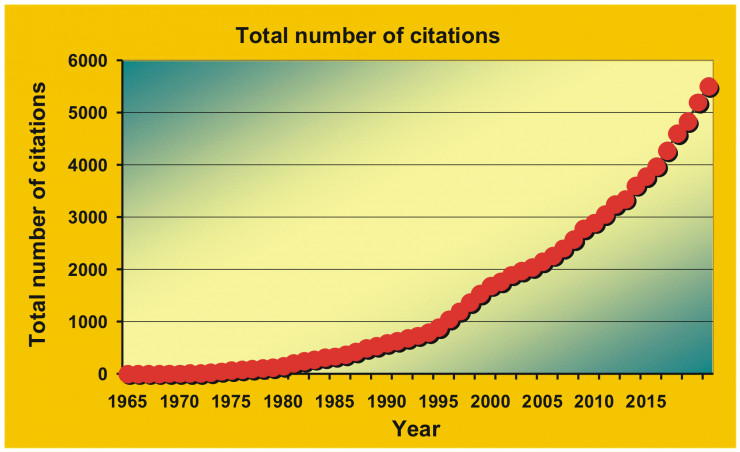Publications and citations
In 1967, when CLEPS was founded, Prof. D.Pavlov established and headed the Lead-Acid Battery Department (LABD). Ever since, more than 50 years now, the research and development activities of the LABD have been focused on the lead-acid battery theory and technology. Today, the LABD of IEES (former CLEPS) is an integral research organization capable of resolving and consulting about all kinds of fundamental, technological and design problems related to lead-acid batteries.
Total number of papers published throughout the years

Most of the results of the research efforts of the LABD team have been summarized in more than 300 publications in international journals and conference proceedings,
The international battery community shows vivid interest in the scientific production of the LABD
Total number of citations throughout the years

By the end of 2018 LABD works have more than 5500 citations by authors from all over the world.

The maxima in the column chart correspond to the following scientific achievements
1st maximum
- Identification of Pb/PbO/PbSO4 electrode in the potential region between PbO2/PbSO4 and Pb/PbSO4 electrodes
2nd maximum
- Disclosure of the membrane behaviour of the PbSO4 layer formed on anodic polarization of Pb electrode in H2SO4 solution
- Disclosure of the mechanism of pore alkalization in the PbSO4 membrane and formation of α-PbO
- Mechanism of growth of PbO layer under the PbSO4 membrane during anodic polarization of Pb/PbO/PbSO4
3rd maximum
- Investigation on the photoelectrochemical properties of the Pb/PbO/PbSO4 electrode
- Disclosure of the mechanism of formation of basic lead sulfates during paste preparation
- Detection of ß-PbO during discharge of PbO2 plate in Н2SO4 solution and disclosure of the mechanism of its formation.
4th maximum
- Disclosure of PАМ and NАМ structure - a skeleton energy model
- Experiential detection of the gel-crystal structure of PbO2 particles and its influence on the discharge of battery positive plates
- Experiential identification of skeleton and energetic structures of lead-acid battery negative active mass
- Elucidation of the phenomena at the interface grid/PAM causing Premature Capacity Loss (PCL-1)
5th maximum
- Disclosure of the mechanism of oxygen evolution on polarization of Pb/PbO2 electrode
- Experiential identification of the reactions involved in the closed oxygen cycle in Valve Regulated Lead-Acid Batteries
- Elucidation of the processes causing Thermal Run Away
- Investigation into the thermal phenomena during VRLAB operation
- Invention of Modified Adsorptive Glass Mat (MAGM) separator
- Investigation into the influence of Н2SO4 concentration on the performance of LAB with PbSnCa grids.
6th maximum
- Disclosure of the mechanism of action of carbon additives to negative active mass
- Investigation into the influence of some polymer additives on VRLAB operation
- Publication of the books which present a comprehensive overview of the technological processes of lead-acid battery manufacture and their influence on performance parameters.

